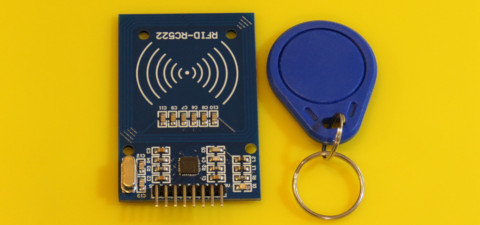Passive RFID tags are basically just little antennas with an extremely low power integrated circuit. When the IC is activated by power induced by the antenna, it generates a signal to transmit a small amount of data, such as an ID number.
This RC522 RFID module can read RFID tags and write to RFID tags that support writing. The RFID tag has a 4-byte (or 32-bit) UID, which means there are about 4.3 billion unique possibilities. Although that sounds like a lot, there are some situations where it's not considered enough to prevent collisions or brute-force guessing.
RFID tags, on their own, are not very suitable for access control in a modern high-security environment. However, it will typically be harder for an intruder to guess a 32-bit UID than, for example, to pick a traditional house lock using standard lockpicking tools and a little practice.
The RFID tag is called a PICC, short for Proximity Integrated Circuit Card because "tag" is apparently too easy.
This sample code will print the PICC type and UID to the serial port:
#include <SPI.h>
#include <MFRC522.h>
const byte RST_PIN = 9;
const byte SS_PIN = 10;
MFRC522 reader(SS_PIN, RST_PIN);
void printUID(byte* bytes, byte len)
{
Serial.print("UID: ");
for (byte i = 0; i < len; i++) {
// Pad single-digits with 0
if (bytes[i] < 0x10) {
Serial.print("0");
}
Serial.print(bytes[i], HEX);
}
Serial.println();
}
void printPiccType(byte sak)
{
Serial.print("SAK: ");
Serial.println(sak);
auto piccType = reader.PICC_GetType(sak);
auto piccTypeName = reader.PICC_GetTypeName(piccType);
Serial.print("PICC type: ");
Serial.println(piccTypeName);
}
void setup()
{
Serial.begin(9600);
SPI.begin();
reader.PCD_Init();
}
void loop()
{
delay(50);
bool cardFound = reader.PICC_IsNewCardPresent();
bool cardRead = reader.PICC_ReadCardSerial();
if (cardFound && cardRead) {
auto uid = reader.uid;
printUID(uid.uidByte, uid.size);
printPiccType(uid.sak);
delay(200);
}
}
